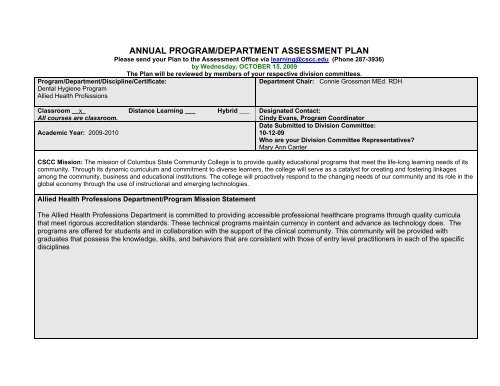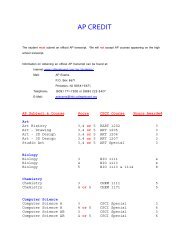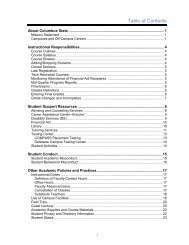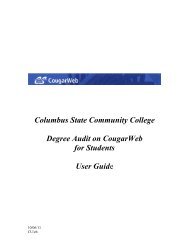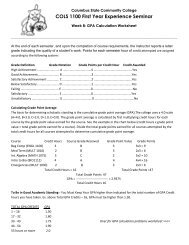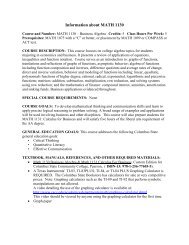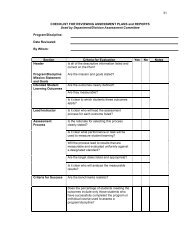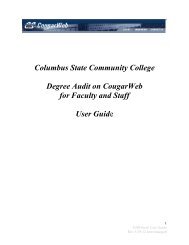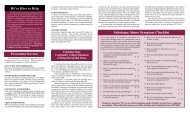annual program/department assessment plan - Columbus State ...
annual program/department assessment plan - Columbus State ...
annual program/department assessment plan - Columbus State ...
You also want an ePaper? Increase the reach of your titles
YUMPU automatically turns print PDFs into web optimized ePapers that Google loves.
Program/Department/Discipline/Certificate:Dental Hygiene ProgramAllied Health ProfessionsANNUAL PROGRAM/DEPARTMENT ASSESSMENT PLANPlease send your Plan to the Assessment Office via learning@cscc.edu (Phone 287-3936)by Wednesday, OCTOBER 15, 2009The Plan will be reviewed by members of your respective division committees.Department Chair: Connie Grossman MEd. RDHClassroom __x_ Distance Learning ___ Hybrid ___All courses are classroom.Academic Year: 2009-2010Designated Contact:Cindy Evans, Program CoordinatorDate Submitted to Division Committee:10-12-09Who are your Division Committee Representatives?Mary Ann CanterCSCC Mission: The mission of <strong>Columbus</strong> <strong>State</strong> Community College is to provide quality educational <strong>program</strong>s that meet the life-long learning needs of itscommunity. Through its dynamic curriculum and commitment to diverse learners, the college will serve as a catalyst for creating and fostering linkagesamong the community, business and educational institutions. The college will proactively respond to the changing needs of our community and its role in theglobal economy through the use of instructional and emerging technologies.Allied Health Professions Department/Program Mission <strong>State</strong>mentThe Allied Health Professions Department is committed to providing accessible professional healthcare <strong>program</strong>s through quality curriculathat meet rigorous accreditation standards. These technical <strong>program</strong>s maintain currency in content and advance as technology does. The<strong>program</strong>s are offered for students and in collaboration with the support of the clinical community. This community will be provided withgraduates that possess the knowledge, skills, and behaviors that are consistent with those of entry level practitioners in each of the specificdisciplines
Dental Hygiene Mission <strong>State</strong>ment:Professional education should provide for self-development as well as for intellectual growth. Education is a multidimensionalprocess involving the acquisition of knowledge with understanding, continual self-growth and maturation, and scholarly inquiry.Thus, the educational format interweaves the basic and clinical sciences, general and basic education courses, and interpersonalrelations to produce a responsible citizen who shows interest and concern for the welfare of self, family and the community.An essential for any professional is the development of a genuine concern for the public’s well being. The dental hygiene <strong>program</strong>encourages the development of non-prejudicial attitudes that recognize people as individuals with personal needs. Ethicalprinciples are actively promoted as the basis for relationships and service. Each graduate is responsible for professional actionsand judgments when rendering public service. The educational <strong>program</strong> strives to meet with the utmost competence and empathythe physical, emotional, and oral health needs of individuals and groups.Student-student and student-faculty interactions aid the student in molding leadership qualities and in promoting the ability to workcooperatively while retaining individuality. Each professional must be able to work in a cooperative setting with other healthprofessionals in a united effort to provide quality total patient care. Participation is expected in professional and civicorganizations as well as in proposed legislation affecting health services to the public.To be competent and effective, the professional must become a lifelong student, one who seeks and applies newknowledge and skills. The student should work continuously and diligently to improve and advance the standards by which theprofession is governed. Equally important, the hygienist must educate and motivate the public to appreciate and practiceexcellent oral health habits, promote overall general health, and encourage the acceptance of responsibility for health-consciousbehavior.The CSCC Dental Hygiene Program recognizes its responsibility to establish and maintain exemplary educational and servicestandards. The delivery of excellent comprehensive patient care is facilitated by open communication between the <strong>department</strong>and other <strong>program</strong>s on and off campus whereby the exchange of information of the latest advancements in health care andeducational modes is encouraged.2
CSCC Dental Hygiene Program Goals/Outcomes1.0 The Dental Hygienist will possess the skills and knowledge to manage the ethical and professional issues of dental hygienepractice.2.0 The Dental Hygienist must be able to acquire and analyze information in a scientific and effective manner using criticalthinking skills.3.0 The Dental Hygienist will be able to demonstrate written comprehension, critical thinking, and skills for the application of<strong>assessment</strong>, dental hygiene diagnosis, <strong>plan</strong>ning, implementation, and evaluation related to the provision of optimal preventive,therapeutic, and educational dental hygiene services to individuals of diverse populations.4.0 The Dental Hygienist will be able to demonstrate knowledge of safe and effective patient care by adherence to proper infectioncontrol, HIPAA requirements, and emergency protocol during the provision of client care.5.0 The Dental Hygienist will be able to initiate and assume responsibility for general health promotion and oral disease preventionthrough participation in community activities using appropriate interpersonal communication and educational strategies6.0 The Dental Hygienist will be able to apply self-<strong>assessment</strong> skills in preparation for life-long learning.3
List selected courses andstudent learning outcomesby quarter to bemeasured during thisacademic year.Lead Instructor(s).Dental Hygiene Program/Allied Health Programs Department Assessment PlanGeneral Education Outcome-1 and Dental Hygiene Program Outcome 3Learning Outcome(s)Courses General EducationProgram or CourseDHY 203 CSCC 1 Critical Thinking- DHY Outcome-3-Critical ThinkingTechniques ISkillsConstance Clark-Full-Time Faculty Clinical CoordinatorQuarter(s)Spring Quarter-2nd quarter,1st yearAssessment ProcessWhy were these outcomesselected? (Rationale)(Assessment Tools to be Used)For each outcome listedabove, describe how it willbe measured? (Brieflydescribe the method(s), i.e.,portfolios, readingslaboratory assignments,presentations, multi-media,simulations, case studyreviews, embedded testquestions etc.)Criteria for Success(BENCHMARK)For the outcomes listedabove, identify the benchmarkand any otherindicators that will be usedto determine success.OutcomeThe Pediatric Notebook is a project that the DentalHygiene Students are assigned in the Special Needstechniques class. This requires written comprehension,critical thinking, and skills for application of providingoptimal preventive, therapeutic and educational dentalhygiene services to individuals of diverse populations.Tools (Method)Pediatric Portfolio Notebook Self-Assessment SheetPediatric Portfolio Notebook Rubric SheetQuizFinal Exam100% of the class to receive 85% or better on the <strong>assessment</strong> of the project.4
List selected courses andstudent learning outcomesby quarter to bemeasured during thisacademic year.Lead Instructor(s).Assessment ProcessWhy were these outcomesselected? (Rationale)(Assessment Tools to be Used)For each outcome listedabove, describe how it willbe measured? (Brieflydescribe the method(s), i.e.,portfolios, readingslaboratory assignments,presentations, multi-media,simulations, case studyreviews, embedded testquestions etc.)Criteria for Success(BENCHMARK)For the outcomes listedabove, identify the benchmarkand any otherindicators that will be usedto determine success.Dental Hygiene Program/Allied Health Programs Department Assessment PlanGeneral Education Outcome-6 and Dental Hygiene Program Outcome 6Learning Outcome(s)CoursesGeneral EducationProgram or CourseDHY 207 CSCC 6DHY Outcome-6-Self-AssessmentTechniques V Information Literacy skills for Life-long learningCindy Evans, Full-Time Faculty Program CoordinatorOutcomeTools (Method)Life skills management is setting the five and ten year goals Portfolio Rubricfor the student’s professional outlook. The Portfolio teachesthe student how the <strong>program</strong> outcomes and the assignments Cover Letter Rubricare threaded throughout the courses.Resume RubricThe process of reflection of projects and experiences that thestudent discovers by going back to the start of the <strong>program</strong> Professional Mission <strong>State</strong>ment Rubricprovide a sense of accomplishment for the each person.Ethic Case Study RubricThis course provides a clear sense of readiness for eachstudent and the faculty to determine if they are really ready to Five-year Professional Goals Rubricgo out in the profession of Dentistry to demonstrate theknowledge, skills and values of an entry-level DentalTen-year Professional Goals RubricHygienist.Continuing Education Advancement Rubric100% of the class to receive 85% or better on the <strong>assessment</strong> of the project.Quarter(s)Spring Quarter-7th quarter,2nd yearCapstone Course5
List selected courses andstudent learning outcomesby quarter to bemeasured during thisacademic year.Lead Instructor(s).Assessment ProcessWhy were these outcomesselected? (Rationale)(Assessment Tools to be Used)For each outcome listedabove, describe how it willbe measured? (Brieflydescribe the method(s), i.e.,portfolios, readingslaboratory assignments,presentations, multi-media,simulations, case studyreviews, embedded testquestions etc.)Criteria for Success(BENCHMARK)For the outcomes listedabove, identify the benchmarkand any otherindicators that will be usedto determine success.Dental Hygiene Program/Allied Health Programs Department Assessment PlanGeneral Education Outcome-4 and Dental Hygiene Program Outcome 2Learning Outcome(s)CoursesGeneral EducationProgram or CourseCSCC 4Quantitative LiteracyDHY 204Techniques IIDHY Outcome-2-Scientificinformation is analyzed in aneffective mannerConnie Grossman, Allied Health Chairperson and Dental Hygiene Adjunct FacultyOutcomeTools (Method)The Nutrition unit in Techniques II class is wherethe student learns about the correct foods toconsume daily and to be more aware of their owndietary habits.Then in the clinic course they put what theylearned to use by performing a 3-part Nutritioncompetency on a clinic patient.Quarter(s)Summer Quarter-3rdquarter, 2nd yearNutrition Project and PaperNutrition Project and Paper Rubric SheetQuiz and Final ExamDHY 220 Clinic II also has an aspect of the Nutrition Project.After learning the didactic and theory of nutrition, the studentmust complete a series of three appointments on a patient inclinic that brings the didactic learning to life in a real clinicexperience.Appointment 1 Nutrition CompetencyAppointment 2 Nutrition CompetencyAppointment 3 Nutrition CompetencyDietary analysis of 3 day food diary of student’s patient todetermine what foods are missing in their diet according tothe Nutrition Pyramid.100% of the class to receive 75% or better on the <strong>assessment</strong> of the project in Techniques class andclinic.6
ASSESSMENT REPORTASSESSMENT RESULTS AND ACTION PLAN October 15, 2010Course-DHY 203 Technique 1Program/Department Assessment Report: Classroom AssessmentResults and Best Practices[What were the results of the<strong>assessment</strong>? What was learnedfrom the results?]Describe the best practices forlearning outcomes that met orexceeded the benchmark.Teaching StrategiesDescribe the teachingstrategies that you will use toimprove student learningparticularly where students fellbelow the <strong>program</strong>/ <strong>department</strong>benchmark.100% of the students earned 85% or better on the pediatric notebook for DHY 103. The Pediatricnotebook is filled with information about children’s teeth. They can take this to private practice andalways have patient education information to show the parents or the child patient.The air polishing quiz 100% of the students earned 85% or better.The final examination, not all the students were above an 85%.Only 78% of the students earned 85% or better on the final examination.How could this be improved? A review in the last class for the final. Also by providing a reviewsheet listing the comprehensive learning expectations for the final exam.Action Plan for ContinuousImprovement Based onResults and Analysis[Based on what was learned,what steps will be taken toimprove student learning?]Describe any changes incurriculum, course sequencingof courses, prerequisites, etc.Identify resource needs.Follow-UpDiscuss how successfully theproposed teaching strategiesfrom the previous year workedduring this academic year.Include benchmarks.There will be no changes in the course sequencing at this time. However, when we go tosemesters in 2012, the curriculum will change by combining this course with another course.The Dental Hygiene student as a rule is a very dedicated student. The organizational and criticalthinking skills that they must develop are the only way to be successful in the <strong>program</strong>. They like avariety of evaluation tools. In this course there are many opportunities of best practices that haveworked from the previous year to make this course successful in the current year.8
ASSESSMENT REPORTASSESSMENT RESULTS AND ACTION PLAN October 15, 2010Course-DHY 207 Techniques VProgram/Department Assessment Report: Classroom AssessmentResults and Best Practices[What were the results of the<strong>assessment</strong>? What was learnedfrom the results?]Describe the best practices forlearning outcomes that met orexceeded the benchmark.Teaching StrategiesDescribe the teachingstrategies that you will use toimprove student learningparticularly where students fellbelow the <strong>program</strong>/ <strong>department</strong>benchmark.Action Plan for ContinuousImprovement Based onResults and Analysis[Based on what was learned,what steps will be taken toimprove student learning?]Describe any changes incurriculum, course sequencingof courses, prerequisites, etc.Identify resource needs.Follow-UpDiscuss how successfully theproposed teaching strategiesfrom the previous year workedduring this academic year.Include benchmarks.100% of the class did receive 85% or better on the <strong>assessment</strong> of the project I feel what waslearned from from this project is that changing it from a hard copy portfolio to an e-portfolio didn’treally make a difference in the result of the grade the students earned.In the past 7 years the portfolio assignment was a notebook with everything printed out and placedin tabbed sections for others to view. This year I changed the assignment to the e-portfolio and thestudents had just as much fun with the project and were still able to reflect on the past two years inthe dental hygiene <strong>program</strong> and write about the topics that were requested of them.Since the success of the e-portfolio was equal to the hard copy portfolio, next year I <strong>plan</strong> to keepthe assignment the same. An advantage of the e-portfolio that a student mentioned to me was thatthey didn’t have the financial cost of the products that were required to use in the hard copyportfolio. The just burned their portfolio on a CD and therefore save a great deal of money. Thatwas truly appreciated around graduation time when all the board exam fee are due.The resource needs are actually less with the e-portfolio. I thought that if they could see their workin hard copy that they would not be as interested in this project. That wasn’t the case at all. Infact, since the students in the last class have all grown up in a technological savvy world, theythought the e-portfolio was more interesting and that they learned more. This generation is use toinstant gratification and making a notebook as a hard copy takes way to much time and they justwant to do a nice project. It didn’t seem to matter to them that it was all electronic.The Dental Hygiene student as a rule is a very dedicated student. The organizational and criticalthinking skills that they must develop are the only way to be successful in the <strong>program</strong>. They like avariety of evaluation tools. In this course there are many opportunities of best practices that haveworked from the previous year to make this course successful in the current year.9
ASSESSMENT REPORTASSESSMENT RESULTS AND ACTION PLAN October 15, 2010Course-DHY 204Program/Department Assessment Report: Classroom AssessmentResults and Best Practices[What were the results of the<strong>assessment</strong>? What was learnedfrom the results?]Describe the best practices forlearning outcomes that met orexceeded the benchmark.Teaching StrategiesDescribe the teachingstrategies that you will use toimprove student learningparticularly where students fellbelow the <strong>program</strong>/ <strong>department</strong>benchmark.Action Plan for ContinuousImprovement Based onResults and Analysis[Based on what was learned,what steps will be taken toimprove student learning?]Describe any changes incurriculum, course sequencingof courses, prerequisites, etc.Identify resource needs.Follow-UpDiscuss how successfully theproposed teaching strategiesfrom the previous year workedduring this academic year.Include benchmarks.All student did receive 75% or higher on the Nutrition Paper and Nutrition Clinic Project. Onestudent did not receive an 85% on the project (she earned an 84%).Thus 93% of the fifteen students earned an 85 or higher. This shows that the three appointmentsin the clinical setting with one patient discussing their own nutrition was a very successful way toput in place teaching patient that “what they eat” makes a big difference in the health of their oralcavitiy.All student were above the benchmark of 75% for this project and class grade overall.Dietary analysis of 3 day food diary of student’s patient was used to determine what foods aremissing in their diet according to the Nutrition Pyramid. Next year, possibly make this appointmentlonger to explain to the patient that they must keep an accurate food diary for three days becauseit is essential to make this part of the nutrition analysis a success.Next year to improve student learning an example of poor work and good work on the assignmentfor the next group will be provided. They will then realize exactly what is expected of them for thishuge assignment.Also, clearer directions will be provided as to required information that they much collect, analysisand implement to make this very important project a success.The Dental Hygiene student as a rule is a very dedicated student. The organizational and criticalthinking skills that they must develop are the only way to be successful in the <strong>program</strong>. They like avariety of evaluation tools. In this course there are many opportunities of best practices that haveworked from the previous year to make this course successful in the current year.10
ASSESSMENT REPORTASSESSMENT RESULTS AND ACTION PLAN October 15,2010Course DHY 215Program/Department Assessment Report: Classroom AssessmentResults and Best Practices[What were the results of the<strong>assessment</strong>? What was learnedfrom the results?]Describe the best practices forlearning outcomes that met orexceeded the benchmark.Teaching StrategiesDescribe the teachingstrategies that you will use toimprove student learningparticularly where students fellbelow the <strong>program</strong>/ <strong>department</strong>benchmark.Action Plan for ContinuousImprovement Based onResults and Analysis[Based on what was learned,what steps will be taken toimprove student learning?]Describe any changes incurriculum, course sequencingof courses, prerequisites, etc.Identify resource needs.Follow-UpDiscuss how successfully theproposed teaching strategiesfrom the previous year workedduring this academic year.Include benchmarks.CLE 10-15-10100% of the students received 80% or better as reported.All peer student evaluations were the grade of S. Each Senior was graded by the entire studentbody of the Dental Hygiene Program. That is 27 students.All faculty grades were the grade of S.The students are provided with a Case Study Preparation Manual during the Autumn Quarter. Thatallows them 3 quarters to find a Case Study patient that meets the criteria. Then they can utilizeall that time to prepare the patient’s, case study models, Full Mouth Series of Radiographs, Intra-Oral Pictures with a digital camera and a power-point presentation along with an 8-10 page reporton the Dental Hygiene Therapy that was provided for this patient.Instead of just giving the students the manual to review on their own, next year the instructor willreview the manual with the students in the Autumn and Winter quarters. The first class in SpringQuarter, an instructor will present an example power-point of a good case study and what shouldbe included. This approach will allow the student more opportunities to use their critical thinkingskills to analysis the material required for this Cap Stone Project for the Dental Hygiene Program.The Dental Hygiene student as a rule is a very dedicated student. The organizational and criticalthinking skills that they must develop are the only way to be successful in the <strong>program</strong>. They like avariety of evaluation tools. In this course there are many opportunities of best practices that haveworked from the previous year to make this course successful in the current year.11


